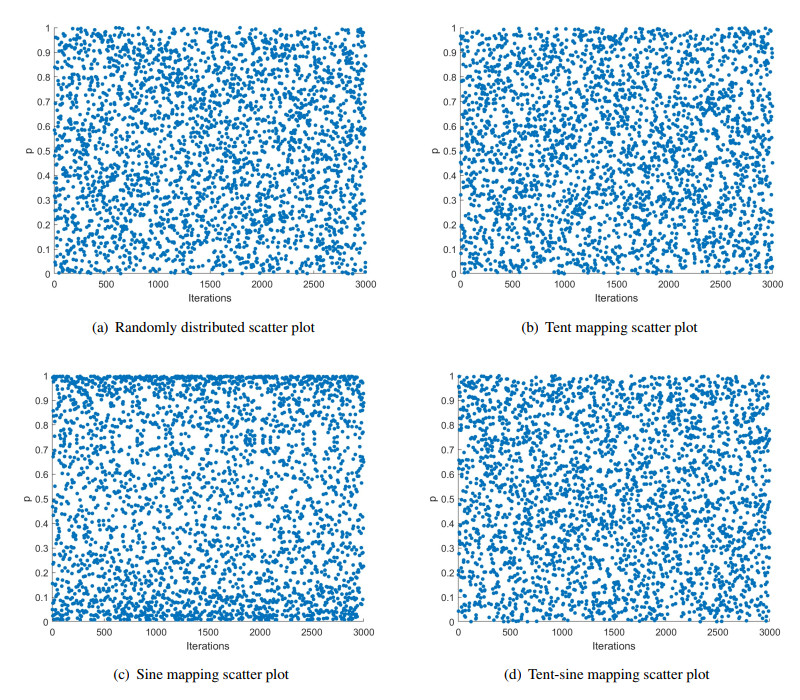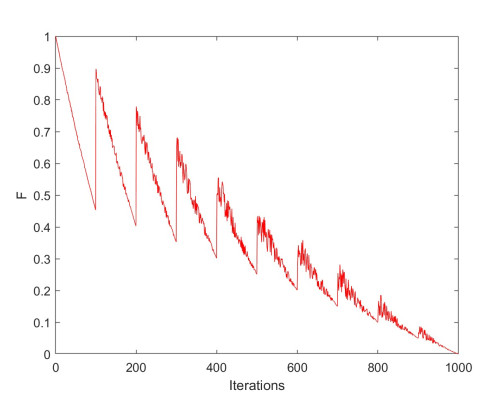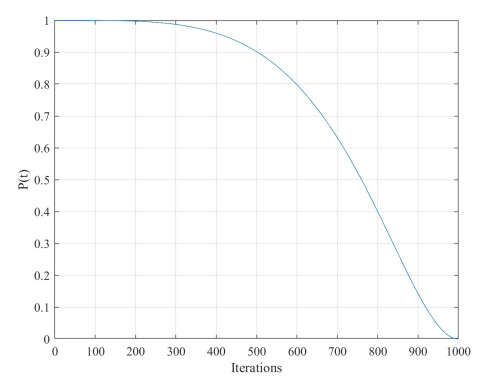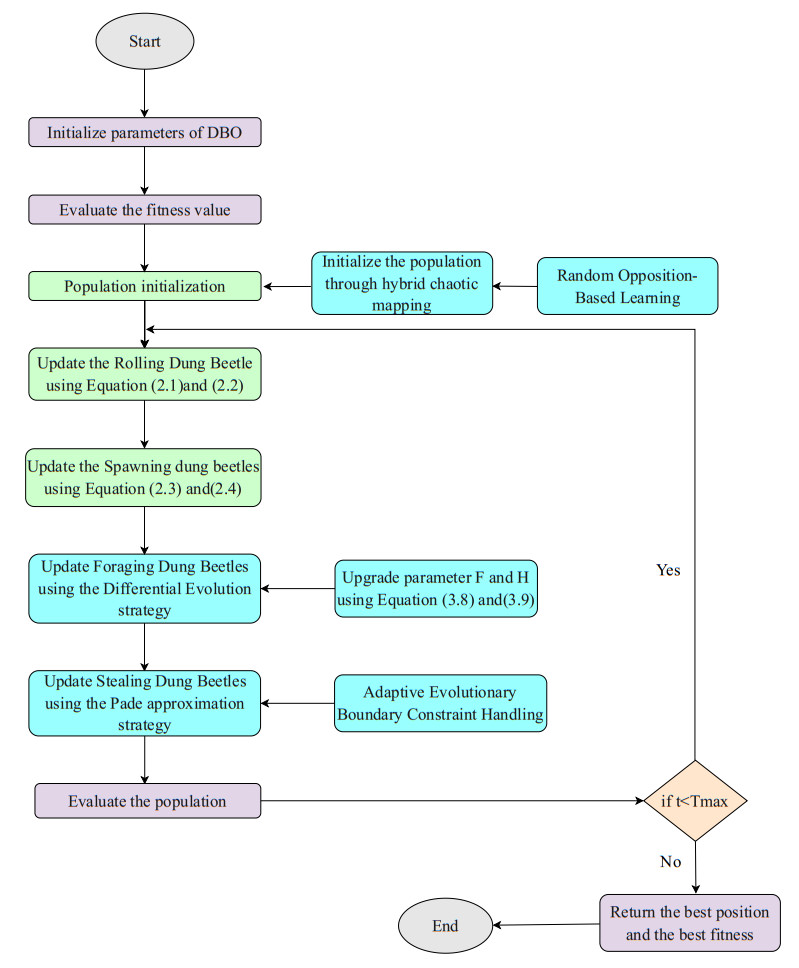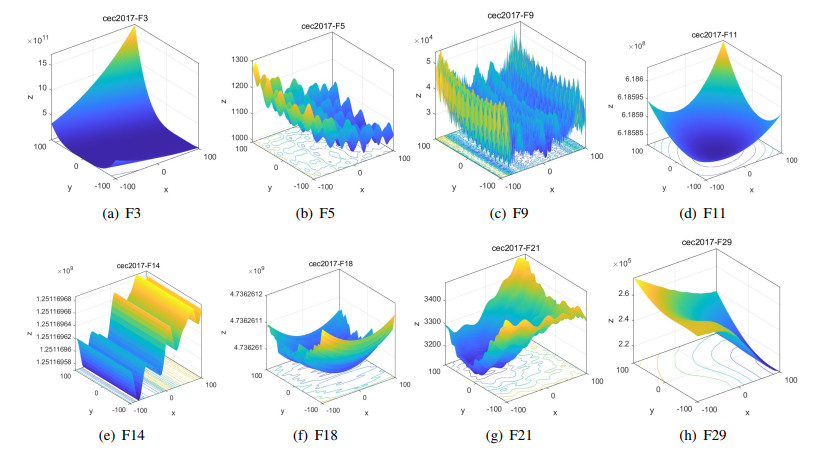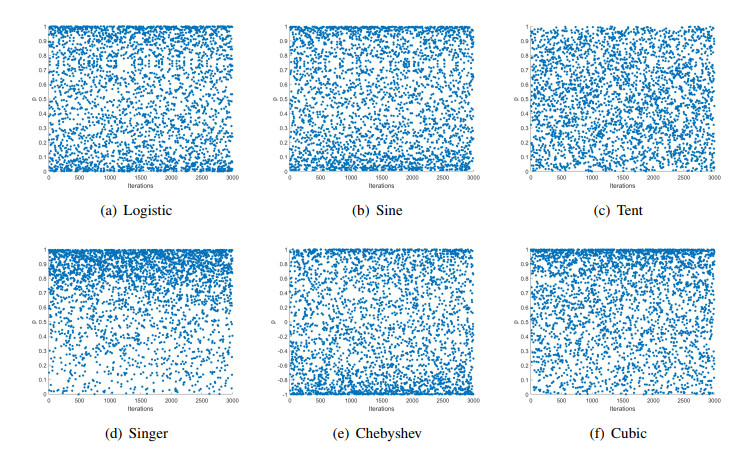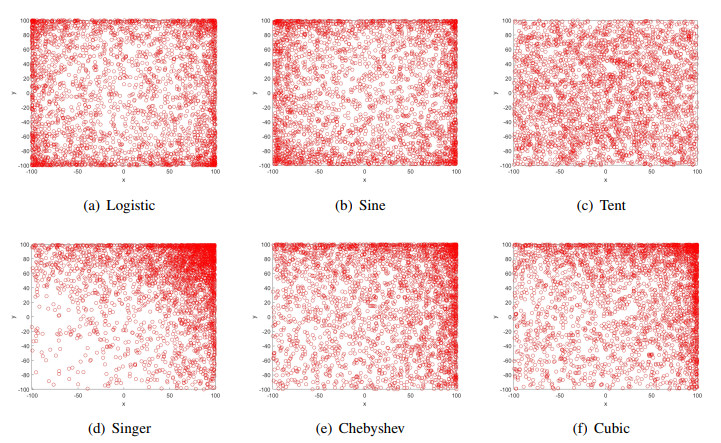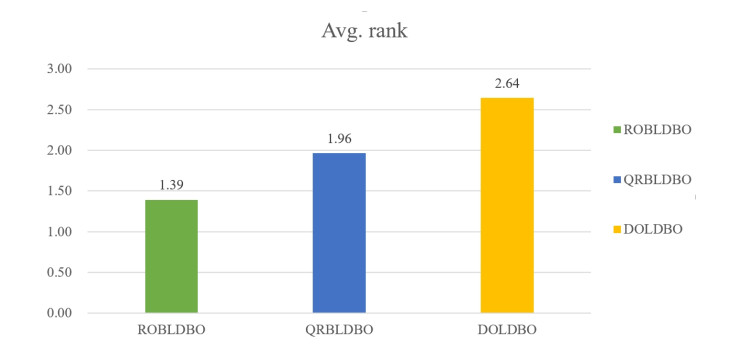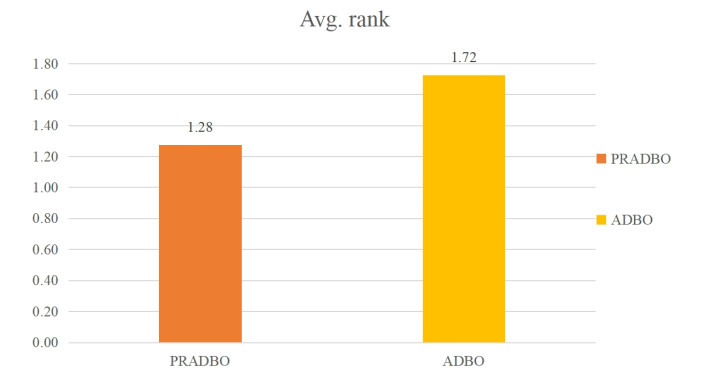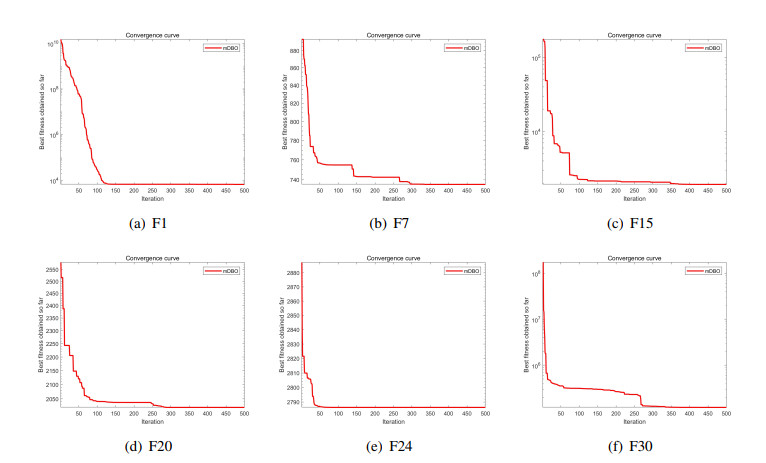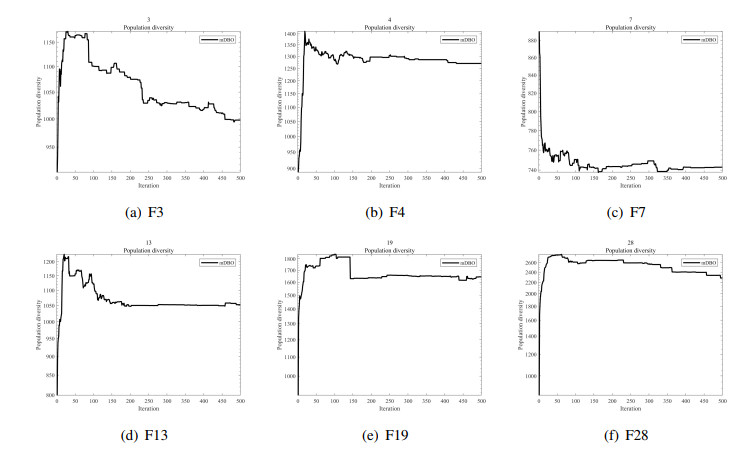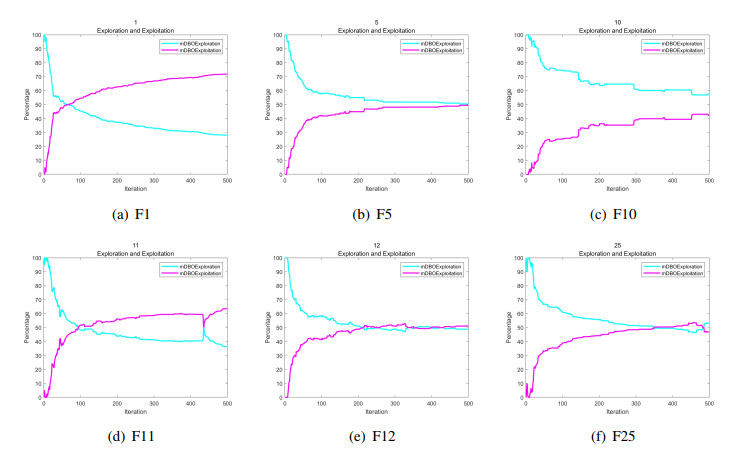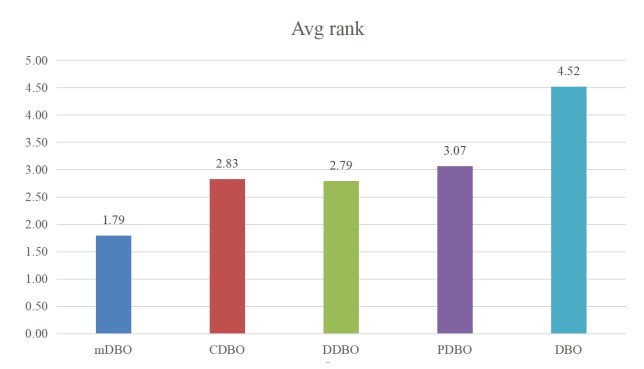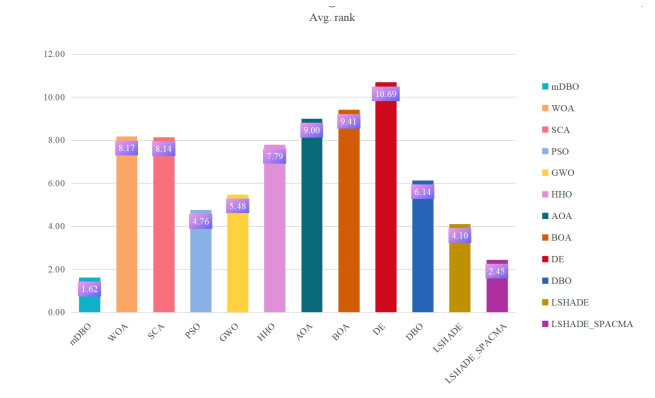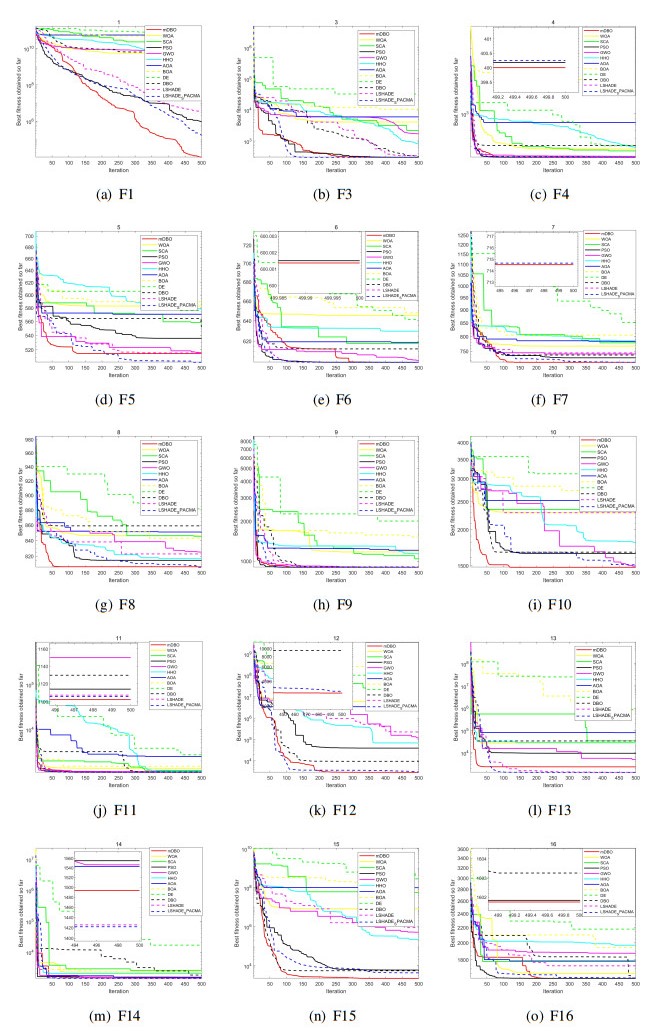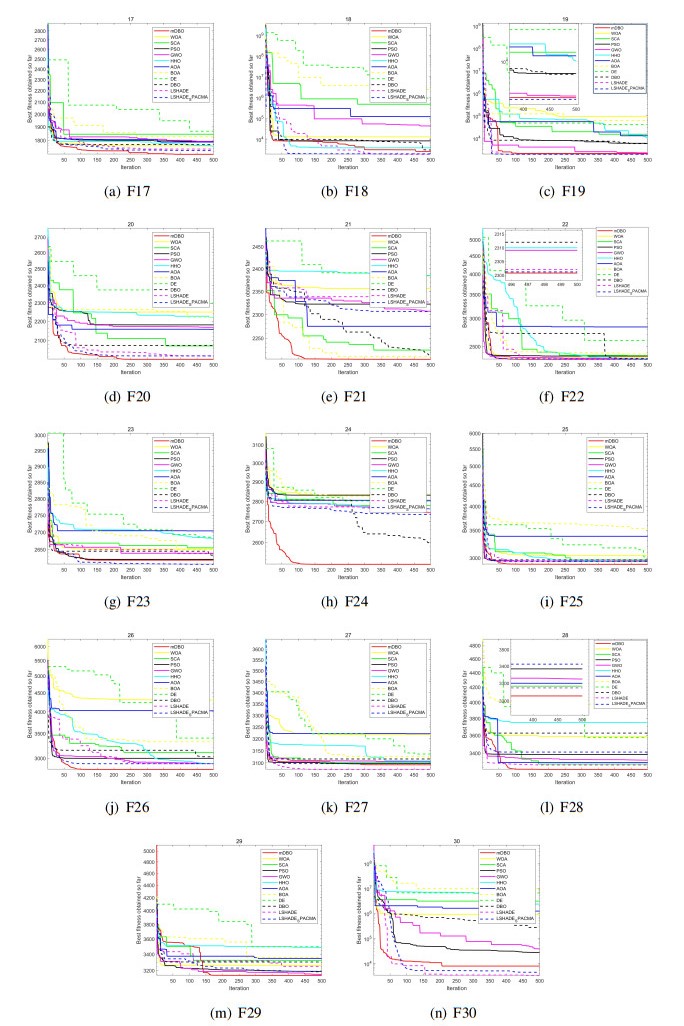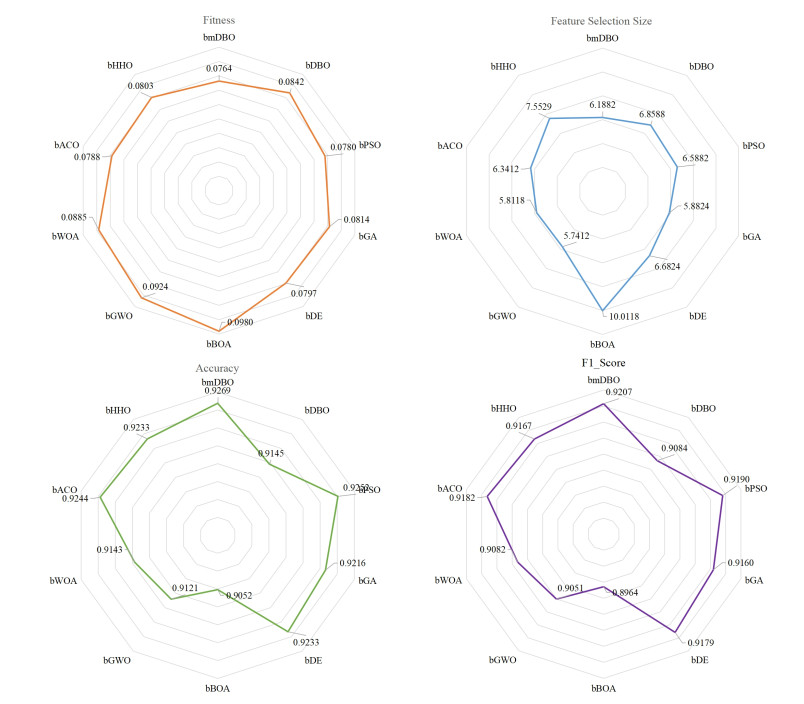|
[1]
|
M. Azizi, U. Aickelin, H. A. Khorshidi, M. Baghalzadeh-Shishehgarkhaneh, Energy valley optimizer: A novel metaheuristic algorithm for global and engineering optimization, Sci. Rep., 13 (2023), 226. https://doi.org/10.1038/s41598-022-27344-y doi: 10.1038/s41598-022-27344-y

|
|
[2]
|
F. A. Hashim, E. H. Houssein, K. Hussain, M. S. Mabrouk, W. Al-Atabany, Honey badger algorithm: New metaheuristic algorithm for solving optimization problems, Math. Comput. Simul., 192 (2022), 84–110. https://doi.org/10.1016/j.matcom.2021.08.013 doi: 10.1016/j.matcom.2021.08.013

|
|
[3]
|
S. Gupta, H. Abderazek, B. S. Yıldız, A. R. Yildiz, S. Mirjalili, S. M. Sait, Comparison of metaheuristic optimization algorithms for solving constrained mechanical design optimization problems, Exp. Syst. Appl., 183 (2021), 115351. https://doi.org/10.1016/j.eswa.2021.115351 doi: 10.1016/j.eswa.2021.115351

|
|
[4]
|
S. Aslan, T. Erkin, An immune plasma algorithm based approach for ucav path planning, J. King Saud Univ. Comput. Inf. Sci., 35 (2023), 56–69. https://doi.org/10.1016/j.jksuci.2022.06.004 doi: 10.1016/j.jksuci.2022.06.004

|
|
[5]
|
L. Abualigah, K. H. Almotairi, M. A. Elaziz, Multilevel thresholding image segmentation using meta-heuristic optimization algorithms: Comparative analysis, open challenges and new trends, Appl. Intell., 53 (2023), 11654–11704. https://doi.org/10.1007/s10489-022-04064-4 doi: 10.1007/s10489-022-04064-4

|
|
[6]
|
M. Chan-Ley, G. Olague, Categorization of digitized artworks by media with brain programming, Appl. Opt., 59 (2020), 4437–4447, 2020. https://doi.org/10.1364/AO.385552 doi: 10.1364/AO.385552

|
|
[7]
|
Y. Li, G. Tian, Y. Yi, Y. Yuan, Improved artificial rabbit optimization and its application in multichannel signal denoising, IEEE Sensors J., 2024 (2024). https://doi.org/10.1109/JSEN.2024.3456290 doi: 10.1109/JSEN.2024.3456290

|
|
[8]
|
Y. Xiao, H. Cui, A. G. Hussien, F. A. Hashim, MSAO: A multi-strategy boosted snow ablation optimizer for global optimization and real-world engineering applications, Adv. Eng. Inf., 61 (2024), 102464. https://doi.org/10.1016/j.aei.2024.102464 doi: 10.1016/j.aei.2024.102464

|
|
[9]
|
X. Fei, J. Wang, S. Ying, Z. Hu, J. Shi, Projective parameter transfer based sparse multiple empirical kernel learning machine for diagnosis of brain disease, Neurocomputing, 413 (2020), 271–283. https://doi.org/10.1016/j.neucom.2020.07.008 doi: 10.1016/j.neucom.2020.07.008

|
|
[10]
|
Z. Ma, X. Li, An improved supervised and attention mechanism-based u-net algorithm for retinal vessel segmentation, Comput. Biol. Med., 168 (2024), 107770. https://doi.org/10.1016/j.compbiomed.2023.107770 doi: 10.1016/j.compbiomed.2023.107770

|
|
[11]
|
Y. Xiao, Y. Guo, H. Cui, Y. Wang, J. Li, Y. Zhang, IHAOAVOA: An improved hybrid aquila optimizer and African vultures optimization algorithm for global optimization problems, Math. Biosci. Eng., 19 (2022), 10963–11017. https://doi.org/10.3934/mbe.2022512 doi: 10.3934/mbe.2022512

|
|
[12]
|
J. Zhang, M. Xiao, L. Gao, Q. Pan, Queuing search algorithm: A novel metaheuristic algorithm for solving engineering optimization problems, Appl. Math. Modell., 63 (2018), 464–490. https://doi.org/10.1016/j.apm.2018.06.036 doi: 10.1016/j.apm.2018.06.036

|
|
[13]
|
U. Kamath, K. De Jong, A. Shehu, Effective automated feature construction and selection for classification of biological sequences, PloS One, 9 (2014), e99982. https://doi.org/10.1371/journal.pone.0099982 doi: 10.1371/journal.pone.0099982

|
|
[14]
|
F. Thabtah, F. Kamalov, S. Hammoud, S. R. Shahamiri, Least loss: A simplified filter method for feature selection, Inf. Sci., 534 (2020), 1–15. https://doi.org/10.1016/j.ins.2020.05.017 doi: 10.1016/j.ins.2020.05.017

|
|
[15]
|
L. Sun, J. Zhang, W. Ding, J. Xu, Feature reduction for imbalanced data classification using similarity-based feature clustering with adaptive weighted k-nearest neighbors, Inf. Sci., 593 (2022), 591–613. https://doi.org/10.1016/j.ins.2022.02.004 doi: 10.1016/j.ins.2022.02.004

|
|
[16]
|
Z. Tao, L. Huiling, W. Wenwen, Y. Xia, GA-SVM based feature selection and parameter optimization in hospitalization expense modeling, Appl. Soft Comput., 75 (2019), 323–332. https://doi.org/10.1016/j.asoc.2018.11.001 doi: 10.1016/j.asoc.2018.11.001

|
|
[17]
|
H. Liu, Z. Zhao, Manipulating data and dimension reduction methods: Feature selection, in Computational Complexity: Theory, Techniques, and Applications, Springer, (2012), 790–1800. https://doi.org/10.1007/978-1-4614-1800-9_115
|
|
[18]
|
M. Rostami, K. Berahmand, E. Nasiri, S. Forouzandeh, Review of swarm intelligence-based feature selection methods, Eng. Appl. Artif. Intell., 100 (2021), 104210. https://doi.org/10.1016/j.engappai.2021.104210 doi: 10.1016/j.engappai.2021.104210

|
|
[19]
|
D. H. Wolpert, W. G. Macready, No free lunch theorems for optimization, IEEE Trans. Evol. Comput., 1 (1997), 67–82. https://doi.org/10.1109/4235.585893 doi: 10.1109/4235.585893

|
|
[20]
|
X. Song, Y. Zhang, D. Gong, X. Sun, Feature selection using bare-bones particle swarm optimization with mutual information, Pattern Recognit., 112 (2021), 107804. https://doi.org/10.1016/j.patcog.2020.107804 doi: 10.1016/j.patcog.2020.107804

|
|
[21]
|
H. Faris, M. M. Mafarja, A. A. Heidari, I. Aljarah, A. M. Al-Zoubi, S. Mirjalili, et al., An efficient binary salp swarm algorithm with crossover scheme for feature selection problems, Knowl. Based Syst., 154 (2018), 43–67. https://doi.org/10.1016/j.knosys.2018.05.009 doi: 10.1016/j.knosys.2018.05.009

|
|
[22]
|
E. Emary, H. M. Zawbaa, A. E. Hassanien, Binary grey wolf optimization approaches for feature selection, Neurocomputing, 172 (2016), 371–381. https://doi.org/10.1016/j.neucom.2015.06.083 doi: 10.1016/j.neucom.2015.06.083

|
|
[23]
|
Y. Zhao, J. Dong, X. Li, H. Chen, S. Li, A binary dandelion algorithm using seeding and chaos population strategies for feature selection, Appl. Soft Comput., 125 (2022), 109166. https://doi.org/10.1016/j.asoc.2022.109166 doi: 10.1016/j.asoc.2022.109166

|
|
[24]
|
M. Mafarja, S. Mirjalili, Whale optimization approaches for wrapper feature selection, Appl. Soft Comput., 62 (2018), 441–453. https://doi.org/10.1016/j.asoc.2017.11.006 doi: 10.1016/j.asoc.2017.11.006

|
|
[25]
|
A. Adamu, M. Abdullahi, S. B. Junaidu, I. H. Hassan, An hybrid particle swarm optimization with crow search algorithm for feature selection, Mach. Learn. Appl., 6 (2021), 100108. https://doi.org/10.1016/j.mlwa.2021.100108 doi: 10.1016/j.mlwa.2021.100108

|
|
[26]
|
Y. Xue, T. Tang, A. X. Liu, Large-scale feedforward neural network optimization by a self-adaptive strategy and parameter based particle swarm optimization, IEEE Access, 7 (2019), 52473–52483. https://doi.org/10.1109/ACCESS.2019.2911530 doi: 10.1109/ACCESS.2019.2911530

|
|
[27]
|
E. Aličković, A. Subasi, Breast cancer diagnosis using GA feature selection and rotation forest, Neural Comput. Appl., 28 (2017), 753–763. https://doi.org/10.1007/s00521-015-2103-9 doi: 10.1007/s00521-015-2103-9

|
|
[28]
|
B. Xue, M. Zhang, W. N. Browne, X. Yao, A survey on evolutionary computation approaches to feature selection, IEEE Trans. Evol. Comput., 20 (2015), 606–626. https://doi.org/10.1109/TEVC.2015.2504420 doi: 10.1109/TEVC.2015.2504420

|
|
[29]
|
N. Khodadadi, E. Khodadadi, Q. Al-Tashi, E. S. M. El-Kenawy, L. Abualigah, S. J. Abdulkadir, et al., BAOA: Binary arithmetic optimization algorithm with K-nearest neighbor classifier for feature selection, IEEE Access, 11 (2023), 94094–94115. https://doi.org/10.1109/ACCESS.2023.3310429 doi: 10.1109/ACCESS.2023.3310429

|
|
[30]
|
W. N. Chen, D. Z. Tan, Q. Yang, T. Gu, J. Zhang, Ant colony optimization for the control of pollutant spreading on social networks, IEEE Trans. Cybern., 50 (2019), 4053–4065. https://doi.org/10.1109/TCYB.2019.2922266 doi: 10.1109/TCYB.2019.2922266

|
|
[31]
|
H. Hichem, M. Elkamel, M. Rafik, M. T. Mesaaoud, C. Ouahiba, A new binary grasshopper optimization algorithm for feature selection problem, J. King Saud University Comput. Inf. Sci., 34 (2022), 316–328. https://doi.org/10.1016/j.jksuci.2019.11.007 doi: 10.1016/j.jksuci.2019.11.007

|
|
[32]
|
A. A. Alhussan, A. A. Abdelhamid, E. S. M. El-Kenawy, A. Ibrahim, M. M. Eid, D. S. Khafaga, et al., A binary waterwheel plant optimization algorithm for feature selection, IEEE Access, 11 (2023), 94227–94251. https://doi.org/10.1109/ACCESS.2023.3312022 doi: 10.1109/ACCESS.2023.3312022

|
|
[33]
|
K. Nag, N. R. Pal, A multiobjective genetic programming-based ensemble for simultaneous feature selection and classification, IEEE Trans. Cybern., 46 (2015), 499–510. https://doi.org/10.1109/TCYB.2015.2404806 doi: 10.1109/TCYB.2015.2404806

|
|
[34]
|
J. Xue, B. Shen, Dung beetle optimizer: A new meta-heuristic algorithm for global optimization, J. Supercomput., 79 (2023), 7305–7336. https://doi.org/10.1007/s11227-022-04959-6 doi: 10.1007/s11227-022-04959-6

|
|
[35]
|
X. Yao, Y. Liu, G. Lin, Evolutionary programming made faster, IEEE Trans. Evol. Comput., 3 (1999), 82–102. https://doi.org/10.1109/4235.771163 doi: 10.1109/4235.771163

|
|
[36]
|
T. Y. Wu, H. Li, S. C. Chu, CPPE: An improved phasmatodea population evolution algorithm with chaotic maps, Mathematics, 11 (2023), 1977. https://doi.org/10.3390/math11091977 doi: 10.3390/math11091977

|
|
[37]
|
P. Qu, Q. Yuan, F. Du, Q. Gao, An improved manta ray foraging optimization algorithm, Sci. Rep., 14 (2024), 10301. https://doi.org/10.1038/s41598-024-59960-1 doi: 10.1038/s41598-024-59960-1

|
|
[38]
|
H. Yu, Y. Wang, H. Jia, L. Abualigah, Modified prairie dog optimization algorithm for global optimization and constrained engineering problems, Math. Biosci. Eng, 20 (2023), 19086–19132. https://doi.org/10.3934/mbe.2023844 doi: 10.3934/mbe.2023844

|
|
[39]
|
C. Liu, L. Li, Y. Qiang, S. Zhang, Predicting construction accidents on sites: An improved atomic search optimization algorithm approach, Eng. Rep., 6 (2024), e12773. https://doi.org/10.1002/eng2.12773 doi: 10.1002/eng2.12773

|
|
[40]
|
A. Bisht, M. Dua, S. Dua, A novel approach to encrypt multiple images using multiple chaotic maps and chaotic discrete fractional random transform, J. Ambient Intell. Humanized Comput., 10 (2019), 3519–3531. https://doi.org/10.1007/s12652-018-1072-0 doi: 10.1007/s12652-018-1072-0

|
|
[41]
|
Y. Zhou, L. Bao, C. L. P. Chen, A new 1D chaotic system for image encryption, Signal Process., 97 (2014), 172–182. https://doi.org/10.1016/j.sigpro.2013.10.034 doi: 10.1016/j.sigpro.2013.10.034

|
|
[42]
|
F. Han, X. Liao, B. Yang, Y. Zhang, A hybrid scheme for self-adaptive double color-image encryption, Multimedia Tools Appl., 77 (2018), 14285–14304. https://doi.org/10.1007/s11042-017-5029-7 doi: 10.1007/s11042-017-5029-7

|
|
[43]
|
H. R. Tizhoosh, Opposition-based learning: A new scheme for machine intelligence, in International Conference on Computational Intelligence for Modelling, Control and Automation and International Conference on Intelligent Agents, Web Technologies and Internet Commerce (CIMCA-IAWTIC'06), 1 (2005), 695–701. https://doi.org/10.1109/CIMCA.2005.1631345
|
|
[44]
|
S. Rahnamayan, H. R. Tizhoosh, M. M. A. Salama, Opposition-based differential evolution, IEEE Trans. Evol. Comput., 12 (2008), 64–79. https://doi.org/10.1109/TEVC.2007.894200 doi: 10.1109/TEVC.2007.894200

|
|
[45]
|
H. Wang, Z. Wu, S. Rahnamayan, Y. Liu, M. Ventresca, Enhancing particle swarm optimization using generalized opposition-based learning, Inf. Sci., 181 (2011), 4699–4714. https://doi.org/10.1016/j.ins.2011.03.016 doi: 10.1016/j.ins.2011.03.016

|
|
[46]
|
M. Abd Elaziz, D. Oliva, S. Xiong, An improved opposition-based sine cosine algorithm for global optimization, Exp. Syst. Appl., 90 (2017), 484–500. https://doi.org/10.1016/j.eswa.2017.07.043 doi: 10.1016/j.eswa.2017.07.043

|
|
[47]
|
W. Long, J. Jiao, X. Liang, S. Cai, M. Xu, A random opposition-based learning grey wolf optimizer, IEEE Access, 7 (2019), 113810–113825. https://doi.org/10.1109/ACCESS.2019.2934994 doi: 10.1109/ACCESS.2019.2934994

|
|
[48]
|
R. Storn, K. Price, Differential evolution–-a simple and efficient heuristic for global optimization over continuous spaces, J. Global Optim., 11 (1997), 341–359. https://doi.org/10.1023/A:1008202821328 doi: 10.1023/A:1008202821328

|
|
[49]
|
A. Nickabadi, M. M. Ebadzadeh, R. Safabakhsh, A novel particle swarm optimization algorithm with adaptive inertia weight, Appl. Soft Comput., 11 (2011), 3658–3670. https://doi.org/10.1016/j.asoc.2011.01.037 doi: 10.1016/j.asoc.2011.01.037

|
|
[50]
|
Y. Honshuku, H. Isakari, A topology optimisation of acoustic devices based on the frequency response estimation with the Padé approximation, Appl. Math. Modell., 110 (2022), 819–840. https://doi.org/10.1016/j.apm.2022.06.020 doi: 10.1016/j.apm.2022.06.020

|
|
[51]
|
H. Vazquez-Leal, B. Benhammouda, U. Filobello-Nino, A. Sarmiento-Reyes, V. M. Jimenez-Fernandez, J. L. Garcia-Gervacio, et al., Direct application of Padé approximant for solving nonlinear differential equations, SpringerPlus, 3 (2014), 1–11. https://doi.org/10.1186/2193-1801-3-563 doi: 10.1186/2193-1801-3-563

|
|
[52]
|
I. V. Andrianov, A. Shatrov, Padé approximants, their properties, and applications to hydrodynamic problems, Symmetry, 13 (2021), 1869. https://doi.org/10.3390/sym13101869 doi: 10.3390/sym13101869

|
|
[53]
|
J. Xu, T. Wang, L. Pei, S. Mao, C. Zhu, Parameter identification of electrolyte decomposition state in lithium-ion batteries based on a reduced pseudo two-dimensional model with Padé approximation, J. Power Sources, 460 (2020), 228093. https://doi.org/10.1016/j.jpowsour.2020.228093 doi: 10.1016/j.jpowsour.2020.228093

|
|
[54]
|
A. H. Gandomi, X. S. Yang, Evolutionary boundary constraint handling scheme, Neural Comput. Appl., 21 (2012), 1449–1462. https://doi.org/10.1007/s00521-012-1069-0 doi: 10.1007/s00521-012-1069-0

|
|
[55]
|
A. H. Gandomi, A. R. Kashani, Evolutionary bound constraint handling for particle swarm optimization, in 2016 4th International Symposium on Computational and Business Intelligence (ISCBI), (2016), 148–152. https://doi.org/10.1109/ISCBI.2016.7743274
|
|
[56]
|
A. H. Gandomi, A. R. Kashani, M. Mousavi, Boundary constraint handling affection on slope stability analysis, in Engineering and Applied Sciences Optimization. Computational Methods in Applied Sciences (eds. N. Lagaros and M. Papadrakakis), Springer, (2015), 341–358. https://doi.org/10.1007/978-3-319-18320-6_18
|
|
[57]
|
A. H. Gandomi, A. R. Kashani, F. Zeighami, Retaining wall optimization using interior search algorithm with different bound constraint handling, Int. J. Numer. Anal. Methods Geomech., 41 (2017), 1304–1331. https://doi.org/10.1002/nag.2678 doi: 10.1002/nag.2678

|
|
[58]
|
A. C. Cinar, A comprehensive comparison of accuracy-based fitness functions of metaheuristics for feature selection, Soft Comput., 27 (2023), 8931–8958. https://doi.org/10.1007/s00500-023-08414-3 doi: 10.1007/s00500-023-08414-3

|
|
[59]
|
I. Al-Shourbaji, N. Helian, Y. Sun, S. Alshathri, M. Abd Elaziz, Boosting ant colony optimization with reptile search algorithm for churn prediction, Mathematics, 10 (2022), 1031. https://doi.org/10.3390/math10071031 doi: 10.3390/math10071031

|
|
[60]
|
E. S. M. El-Kenawy, S. Mirjalili, A. Ibrahim, M. Alrahmawy, M. El-Said, R. M. Zaki, et al., Advanced meta-heuristics, convolutional neural networks, and feature selectors for efficient COVID-19 X-ray chest image classification, IEEE Access, 9 (2021). 36019–36037. https://doi.org/10.1109/ACCESS.2021.3061058
|
|
[61]
|
T. Khosla, O. P. Verma, An adaptive hybrid particle swarm optimizer for constrained optimization problem, in 2021 International Conference in Advances in Power, Signal, and Information Technology (APSIT), IEEE, (2021), 1–7. https://doi.org/10.1109/APSIT52773.2021.9641410
|
|
[62]
|
B. D. Kwakye, Y. Li, H. H. Mohamed, E. Baidoo, T. Q. Asenso, Particle guided metaheuristic algorithm for global optimization and feature selection problem, Exp. Syst. Appl., 248 (2024), 123362. https://doi.org/10.1016/j.eswa.2024.123362 doi: 10.1016/j.eswa.2024.123362

|
|
[63]
|
G. Wu, R. Mallipeddi, P. N. Suganthan, Problem definitions and evaluation criteria for the CEC 2017 competition on constrained real-parameter optimization, National University of Defense Technology, Changsha, Hunan, PR China and Kyungpook National University, Daegu, South Korea and Nanyang Technological University, Singapore, Technical Report, 2017.
|
|
[64]
|
S. Mirjalili, A. Lewis, The whale optimization algorithm, Adv. Eng. Software, 95 (2016), 51–67. https://doi.org/10.1016/j.advengsoft.2016.01.008 doi: 10.1016/j.advengsoft.2016.01.008

|
|
[65]
|
S. Mirjalili, SCA: A sine cosine algorithm for solving optimization problems, Knowl. Based Syst., 96 (2016), 120–133. https://doi.org/10.1016/j.knosys.2015.12.022 doi: 10.1016/j.knosys.2015.12.022

|
|
[66]
|
J. Kennedy, R. Eberhart, Particle swarm optimization, in Proceedings of ICNN'95-International Conference on Neural Networks, 4 (1995), 1942–1948. https://doi.org/10.1109/ICNN.1995.488968
|
|
[67]
|
S. Mirjalili, S. M. Mirjalili, A. Lewis, Grey wolf optimizer, Adv. Eng. Software, 69 (2014), 46–61. https://doi.org/10.1016/j.advengsoft.2013.12.007 doi: 10.1016/j.advengsoft.2013.12.007

|
|
[68]
|
A. A. Heidari, S. Mirjalili, H. Faris, I. Aljarah, M. Mafarja, H. Chen, Harris Hawks optimization: Algorithm and applications, Future Gener. Comput. Syst., 97 (2019), 849–872. https://doi.org/10.1016/j.future.2019.02.028 doi: 10.1016/j.future.2019.02.028

|
|
[69]
|
L. Abualigah, A. Diabat, S. Mirjalili, M Abd Elaziz, A. H. Gandomi, The arithmetic optimization algorithm, Comput. Methods Appl. Mech. Eng., 376 (2021), 113609. https://doi.org/10.1016/j.cma.2020.113609 doi: 10.1016/j.cma.2020.113609

|
|
[70]
|
S. Arora, P. Anand, Binary butterfly optimization approaches for feature selection, Exp. Syst. Appl., 116 (2019), 147–160. https://doi.org/10.1016/j.eswa.2018.08.051 doi: 10.1016/j.eswa.2018.08.051

|
|
[71]
|
R. Tanabe, A. S. Fukunaga, Improving the search performance of SHADE using linear population size reduction, in 2014 IEEE Congress on Evolutionary Computation (CEC), (2014), 1658–1665. https://doi.org/10.1109/CEC.2014.6900380
|
|
[72]
|
A. W. Mohamed, A. A. Hadi, A. M. Fattouh, K. M. Jambi, LSHADE with semi-parameter adaptation hybrid with CMA-ES for solving CEC 2017 benchmark problems, in 2017 IEEE Congress on Evolutionary Computation (CEC), (2017), 145–152. https://doi.org/10.1109/CEC.2017.7969307
|
|
[73]
|
S. Zhao, Y. Wu, S. Tan, J. Wu, Z. Cui, Y. G. Wang, QQLMPA: A quasi-opposition learning and Q-learning based marine predators algorithm, Exp. Syst. Appl., 213 (2023), 119246. https://doi.org/10.1016/j.eswa.2022.119246 doi: 10.1016/j.eswa.2022.119246

|
|
[74]
|
Y. Xu, Z. Yang, X. Li, H. Kang, X. Yang, Dynamic opposite learning enhanced teaching-learning-based optimization, Knowl. Based Syst., 188 (2020), 104966. https://doi.org/10.1016/j.knosys.2019.104966 doi: 10.1016/j.knosys.2019.104966

|
|
[75]
|
R. W. Morrison, Designing Evolutionary Algorithms for Dynamic Environments, Springer, 2004. https://doi.org/10.1007/978-3-662-06560-0
|
|
[76]
|
K. Hussain, M. N. M. Salleh, S. Cheng, Y. Shi, On the exploration and exploitation in popular swarm-based metaheuristic algorithms, Neural Comput. Appl., 31 (2019), 7665–7683. https://doi.org/10.1007/s00521-018-3592-0 doi: 10.1007/s00521-018-3592-0

|
|
[77]
|
S. Cheng, Y. Shi, Q. Qin, Q. Zhang, R. Bai, Population diversity maintenance in brain storm optimization algorithm, J. Artif. Intell. Soft Comput. Res., 4 (2014), 83–97. https://doi.org/10.1515/jaiscr-2015-0001 doi: 10.1515/jaiscr-2015-0001

|
|
[78]
|
S. Mirjalili, A. Lewis, S-shaped versus V-shaped transfer functions for binary particle swarm optimization, Swarm Evol. Comput., 9 (2013), 1–14. https://doi.org/10.1016/j.swevo.2012.09.002 doi: 10.1016/j.swevo.2012.09.002

|
|
[79]
|
J. Too, A. R. Abdullah, N. Mohd-Saad, Hybrid binary particle swarm optimization differential evolution-based feature selection for emg signals classification, Axioms, 8 (2019), 79. https://doi.org/10.3390/axioms8030079 doi: 10.3390/axioms8030079

|
|
[80]
|
J. Too, A. R. Abdullah, N. Mohd-Saad, N. Mohd-Ali, W. Tee, A new competitive binary grey wolf optimizer to solve the feature selection problem in emg signals classification, Computers, 7 (2018), 58. https://doi.org/10.3390/computers7040058 doi: 10.3390/computers7040058

|
|
[81]
|
M. H. Aghdam, N. Ghasem-Aghaee, M. E. Basiri, Text feature selection using ant colony optimization, Exp. Syst. Appl., 36 (2009), 6843–6853. https://doi.org/10.1016/j.eswa.2008.08.022 doi: 10.1016/j.eswa.2008.08.022

|
|
[82]
|
J. Too, A. R. Abdullah, N. Mohd-Saad, A new quadratic binary harris hawk optimization for feature selection, Electronics, 8 (2019), 1130. https://doi.org/10.3390/electronics8101130 doi: 10.3390/electronics8101130

|









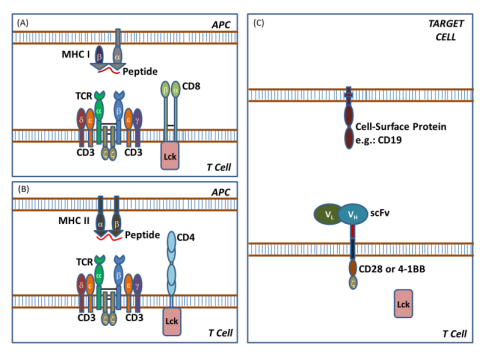
 DownLoad:
DownLoad: 

